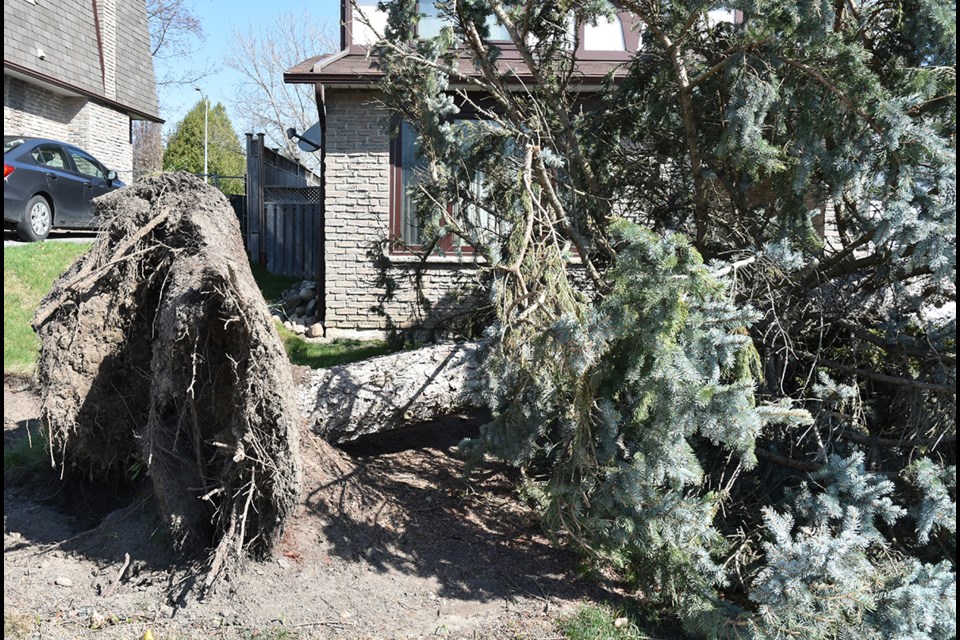In his 50 years as a climatologist, Dave Phillips has seen a lot of weather, and he has seen some disturbing trends.
“Weather seems to be getting more extreme,” Phillips said. “Things are warming, (and) they are getting to be more variable.”
And those are both aspects of climate change that have a direct impact on residents and emergency planning.
Phillips, senior climatologist at Environment Canada, was the keynote speaker at the Emergency Management networking group meeting hosted by Bradford West Gwillimbury on Wednesday.
The session brought together town staff involved in emergency response, including police and fire, and partner agencies such as the Red Cross, Simcoe Muskoka District Health Unit, County of Simcoe emergency management, conservation authorities, even the Ontario Society for the Prevention of Cruelty to Animals.
It is not the general warming of the climate that poses the immediate risk. It is what atmospheric warming leads to, said Phillips.
“It’s greater extremes of weather, more volatile weather,” he told the crowd, referring to “weather whiplash. We’re swinging from floods to drought.”
He gave an example from the Holland Marsh, where farmers experienced two extreme years in a row — the driest growing season one year, followed the next by the wettest.
When the precipitation from both years was averaged out, the result was “normal,” he said, although conditions were anything but.
“I don’t know what normal means anymore,” he said.
And that is important to emergency responders, since most planning standards and responses are based on so-called normal conditions.
If the trends continue, he warned, Canada can expect to go from being “one of the safest countries, weather-wise,” to one more like the U.S., with an increase in severe weather — windstorms, torrential rains, flooding, severe hail, tornadoes.
“Sadly, disasters are a growth sector,” he said. “We’ve got to adapt. We’ve got to accept the fact that our climate is changing. We’ve gone from climate we plan for, to weather we live in… The weather now is not the weather of my youth. Now we’re seeing in our backyards the kind of disasters we thought happened elsewhere.”
And our infrastructure — roads, bridges, stormwater management systems built for “normal” conditions — “is not up to the challenge,” he said.
Phillips cited a number of recent costly disaster in the past two decades, from ice storms, to the 2013 rainstorm in Toronto that dumped more rain in two hours than Hurricane Hazel did in two days.
“Anybody who thinks 100-year storms happen every 100 years, should ask the mayor of Windsor” — a city hit by two 100-year storms in just months. “We’re breaking records at a phenomenal rate.”
And that’s where municipalities come in, he said.
There is a need to retrofit, maintain, and plan, using zoning bylaws to prevent development in floodplains or wetlands — to learn from the disasters that have happened, and promote awareness.
“The more we’re prepared for it, the better off we’ll be,” he said.
Bradford clerk Rebecca Murphy said the town is aware of the challenges posed by climate change and is taking steps to retrofit stormwater ponds and install generators.
"Weather is certainly at the height of our risks," including flooding, ice storms and blizzards, she said.
The town is developing specific emergency plans and encouraging residents to be prepared by listening for alerts and having a 72-hour emergency kit on hand.
Phillips first began to look at climate change and human impact in the 1980s.
“There’s no debate anymore (about) is the world warming? Ninety-eight percent of scientists agree to it. It’s changing just as we said it would,” he said, adding ice caps in Greenland and Antarctica are melting faster than anyone thought, and sea levels are rising faster.
But it is not big-picture climate, but weather change that has caught people’s attention, and is more likely to lead to a change in behaviour, he said.
“Climate change began to hit home when it began hitting our homes,” Phillips said.
And that makes him optimistic about the future.
“We will get it right, but we need to do it now, rather than later.”
Bradford windstorm update: What happened?
Catherine Blair of Alectra also spoke at the Emergency Management networking group meeting Wednesday.
She said Alectra Utilities had nearly 372,000 customers without power during the May 4 windstorm, in an area from St. Catharines, to Markham, to Penetanguishene, by the time the winds settled down Saturday.
By 1 p.m. on Sunday, power had been restored to all but 462 of those customers.
“Everyone worked 24-7,” said Blair. “We would no sooner get a line repaired or a switch repaired, the next gust of wind would bring down another tree.”
The storm caused “a lot of damage to critical infrastructure,” she said, and efforts to restore power were hampered by the need to ensure that efforts were co-ordinated neighbouring power utilities, like Hydro One and Toronto.
Alectra received numerous calls from residents wanting their power restored.
“We want to get to you as soon as we can,” Blair said, but the utility has to “triage” its response, based on what is critical and what is a priority.
One of the problems? Alectra’s outage maps went down: A Google Maps policy limits the number of hits to a site to 25,000 in a 24-hour period, then shuts down the site. Alectra quickly exceeded the limit and is working on the issue.
Blair also issued an urgent reminder to residents, in case of another windstorm: “Please, please stay away from downed wires.”


